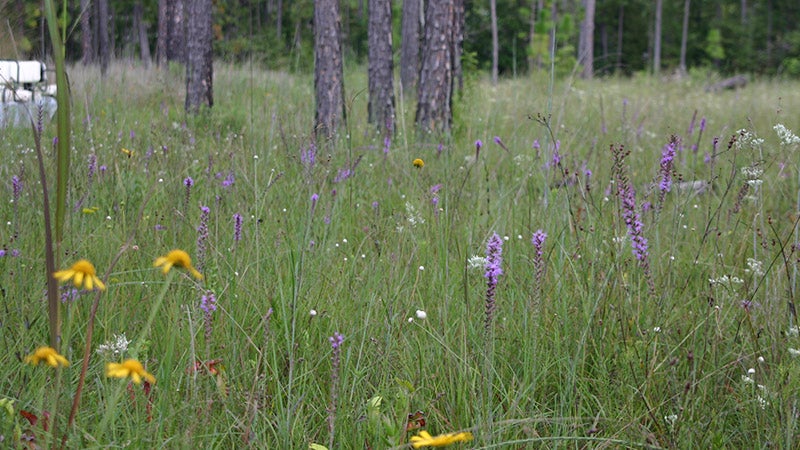Native plants for hummingbirds
Published 10:19 am Tuesday, August 13, 2019

- In late August and early September, the Liatris in the Arboretum’s pitcher plant bog will be beckoning butterflies, and perhaps a few passing hummingbirds. Photo submitted
By Patricia R. Drackett
Director, The Crosby Arboretum, Mississippi State University
Assistant Extension Professor of Landscape Architecture
Last week’s column highlighted a program on hummingbirds that will be held at the Crosby Arboretum this coming Saturday morning. Long-time local bander James Bell returns August 17 at 9:30 a.m. to tell you all about hummingbird migration and how you can fill your yard with these beautiful birds. Details for the program are given at the end of this column. We hope you will give us a call to sign up and reserve your seat.
We recently welcomed a new events coordinator to our staff, Nickie Smith, who is from Picayune. I remember that she had mentioned that when she informed friends and acquaintances about her new association, several told her that they have never been to the Arboretum. Those of you who regularly read this column know that this hummingbird event is one of the many ways that our public garden offers educational opportunities for the community.
Those of you who have never visited, please take a look at our fall schedule of events that will be released very soon. Many of these upcoming events will be fun for the whole family. Staff member Sherri Lowe has been hard at work on Family Pawz Fest on September 28, which offers activities for you and your canine family members. There will be representatives from many local groups, and doggie activities, crafts, and door prizes, so save the date for this great upcoming event.
If you enjoy observing birds that visit your garden, consider the fact that there are many native plants that you can incorporate into your landscape to keep you from having to fill so many feeders! Last week’s column referred to a small spring-blooming tree which is very easy to grow, the red buckeye, and the summer-bloomers, coral honeysuckle vine and cardinal flower.
Other native plant species that will attract hummingbirds include coral bean, southern crabapple, native honeysuckle azaleas, wild blueberries, native iris, and trumpet creeper. Plants from the mint, salvia, and sunflower families are especially attractive to hummers, as are native Monarda, blazing star (Liatris), Phlox, Yucca, and hawthorn (Crataegus) and tulip poplar (Liriodendron).
Southern crabapples (Malus angustifolia) are very attractive spring-blooming trees for the landscape as well as for feeding hummingbirds! They create pale pink flashes along local roadsides. It grows naturally in fields and thickets and on moist, well-drained stream banks. Birds will build their nests among the thorny branches for protection from predators. When southern crabapple is in full bloom, it is definitely a tree that will inspire you to plant it in your landscape. There are several beautiful specimen at our exit gate that have caused many visitors lately to stop their car for photos.
Our pollinator garden includes many perennials that are attractive to hummingbirds, including Monarda, coral bean, and several species of salvia. It is such a delight to watch the birds visiting the garden, which also includes blueberry plants, an excellent source of early spring nectar, planted by the Pearl River County Master Gardeners. Along our woodland paths, native Elliot’s blueberries (Vaccinium elliotii) also beckon in the early spring.
To learn more about the many native and non-native plant species you can include in your landscape to attract hummingbirds, visit the MSU Extension website to download research-based information you can trust at https://extension.msstate.edu. Enter the keyword “hummingbirds” or any other topic you are interested in knowing more about for your home landscape.
The “All About Hummingbirds” program will be held Saturday, August 17, from 9:30 to 10:30 a.m. with James Bell. Learn how to fill your yard with hummingbirds! Suited to ages 8 and up. Members $3, non-member adults $5, members’ children $1, non-member children $2. Reservations required.
A Smart Landscapes program on “Landscaping with Native Plants” will also be held from 1:00 to 2:00 p.m. on the afternoon of Saturday, August. 17. Learn how you can have a low-maintenance and attractive home landscape through using Mississippi native plant species. Arboretum Director Pat Drackett will discuss common and uncommon native plants for landscaping your property, and how to evaluate your planting site in order to choose the appropriate plant material. The program is $2 for members. Non-members $5. Please call to register. Then, on Saturday, August 31, from 9:00 to 10:00 a.m., join Pat Drackett on an early morning field walk to explore the Arboretum exhibits, including the Savanna Exhibit and pitcher plant bog. Members free; non-members $5.
Please call 601-799-2311 to register for programs.The Arboretum is located at 370 Ridge Road in Picayune, at I-59 Exit 4, and open Wednesday through Sunday from 9:00 to 4:30. Leashed pets are always welcome.




